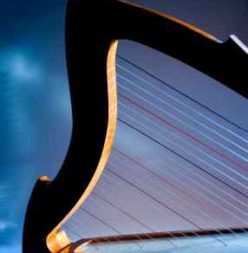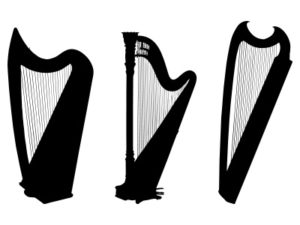Stretch First
Why a tip about stretching in a collection of Celtic Harp Practice Tips? Musicians are athletes. Don’t believe me? There are physical therapists now who specialize in treating musicians for their various injuries. We use our bodies for hours, sometimes, in the same ways, over and over. We forget to take breaks. Worst of all, we don’t stretch or cool down. No wonder we end up in pain!
There are many good resources for stretching exercises, and many stretches are intuitive. By that I mean that if you hold your hands out in front of you for hours, you naturally feel inclined to stretch them behind you to counter the tension. Become a collector of stretches for your hands, arms, shoulders, back, neck–even your legs. Here is a page with some suggestions for stretches:
Have Fun!
Now that you’ve stretched, what do you do when you sit down to practice? I hope you start with something you love! Whatever you do, here’s the key:
Start with play, end with play, and sandwich the technical repetitions in between.
So, before you do anything else, play the piece you love best. Remind yourself why you’re doing this by creating the most beautiful sounds you can. Next, improvise, experiment, play! By the time you play your favorite piece and then improvise, your hands will be warmed up.
Now you can do some exercises, either from an exercise book or pulled out of the tricky spots in your pieces, and they’ll be almost as fun as just playing. After that, work on your newest piece, starting with practice spots (see below).
When you need a mental break, play your “old friends”, the pieces you’ve been polishing that you want to keep. (You love them, remember?) Don’t forget to make it more fun by singing and thinking about the picture the music makes for you, as you play.
Finally, end with some creative play–more improvising, or composing (I’ll give you specific suggestions for these activities in a future article).
Structure Your Practice
Here’s an outline of how your practice could be structured:
Remember: Stretch First.
1. Play your favorite song, or just make the most beautiful sounds on the harp that you can.
2. Improvise. Play a simple 2-chord pattern in your left hand (or even drone one note) and let your right hand find a melody that pleases you.
3. Practice your exercises.
4. Practice your practice spots from your new piece.
Stop for a Stretch Break.
5. Practice your new piece.
6. Play an old friend or two (if you rotate them, you can keep more pieces in your repertoire), focusing on your feelings as you play.
7. Compose or improvise again–make your own music anyway that pleases you.
Be sure to stretch again completely after your practice. If you can, get out and walk or swim (backstroke is a wonderful antidote to harping and typing and all that other stuff we do with our arms out in front of us).
Dispel the Myth that Longer is Better
We all carry that image of the virtuoso musician, locked in her practice room for 8 hours a day. But guess what? Research has proven that those marathon sessions don’t work. It’s the law of diminishing returns, plus the law of sensible effort. So,
if you have only a little time, don’t worry. Short, frequent practices are actually more effective than longer, less-frequent ones.
If you walk by your harp, you can play that spot a few times, and then leave it again. Doing this a few times over the day is far more effective for me than forcing myself to keep working it at one time, so all that research must be right!
Work the Practice Spots
Most of us tend to play what we know, and to play new pieces from beginning to end, stumbling in the same places every time. When we stumble, we either stop and start again in the same place or start over. What do we learn? We learn how to stumble in the same place every single time. There is a much better way!
The secret is “practice spots”. If you know which places are technically difficult, it helps immensely to start with those places, in isolation, and practice them until they’re easy. This means until you play them right, every time, at least 10 times in a row (any mistakes mean starting the counting over). Next, practice your spots with the few measures before and after them attached, again many times right before you put them back in context of the whole piece.
Experiment with this technique, but above all make your practice spots easy, so you won’t get caught up in dread– “here comes the hard part” is the surest way to stumble!
And remember, even the practice spots can be fun, if you focus on playing each passage with beauty.
Record Yourself
There are few more effective ways to gauge your progess with a piece than recording yourself. Video is especially helpful; there is no substitute for watching your own hands as you play the difficult passages. You may think your thumbs are high enough and that you’re closing all your fingers, only to discover that you have plenty of room for improvement. Even audio recording will alert you to where you always stumble, or how you might be pushing the tempo or voicing a passage ineffectively. Use this tool to rocket your playing to a whole new level.
Visualize
Visualization away from the harp (or any instrument) is a powerful technique. Studies have proven it to be as effective as time spent at your instrument. Sometimes, it works even better than actual practice! Simply close your eyes and picture playing a piece or a passage on your harp. Picture each placement of notes, each finger closing into the palm. Hear the music in your mind as you do this. You can take a sequence of movements from a piece of music, and perform them perfectly in your mind. By doing this, your subconscious learns the pattern, so when you’re back at the harp, it has become automatic. I do this often when I’m about to fall asleep. I think the subconscious can take it in even more deeply that way.
Tap Into the Music of Your Soul
Lessons will give you lots of grounding in harp technique, but only you can free the music of your soul. How do you do this? I find that singing is one good way. Sing what you want to play, and then play it. Take your time with a piece. There is no hurry, and the song will evolve for you in its own time. Reflect on the feeling the music evokes in you when you hear it, and let that feeling flow through you before you begin to play. Make sure that every time you play the harp, you improvise and make things up, remembering your delight in all the sounds that lovely harp can make. No matter how old you are or how long you’ve been playing, the harp is an instrument of joy. Let that joy pour through you, and your music will be a dance.


